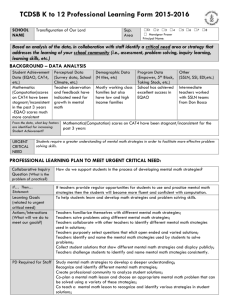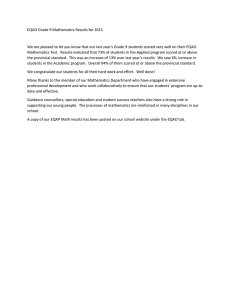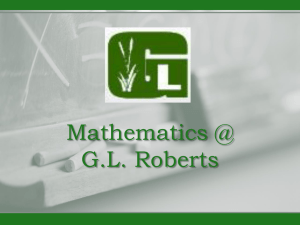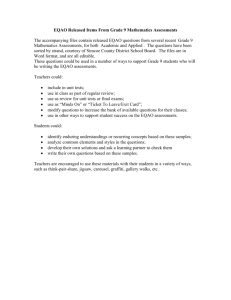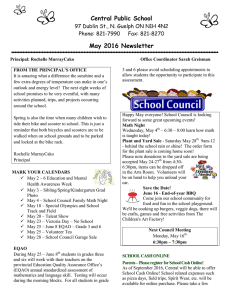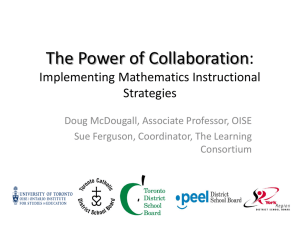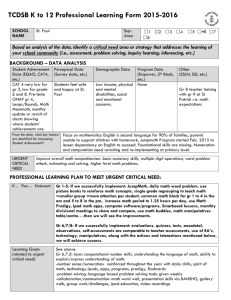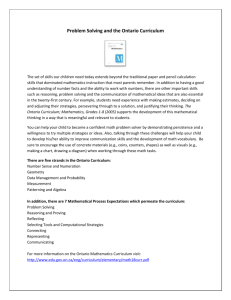Professional Learning Plan 2015 2016
advertisement
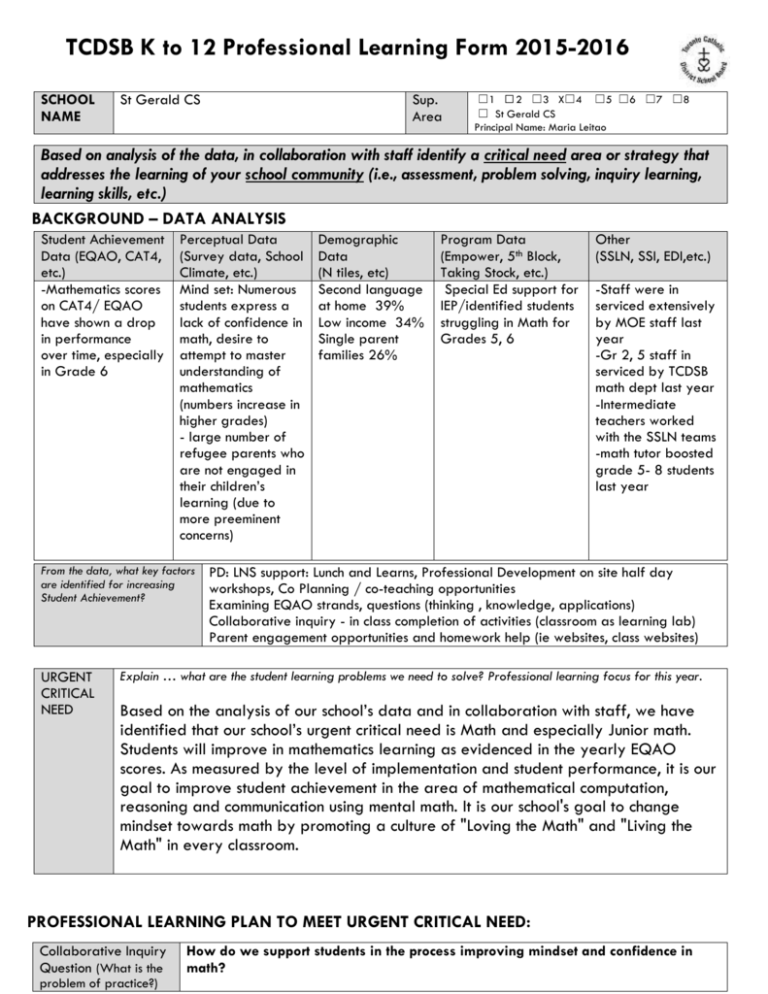
TCDSB K to 12 Professional Learning Form 2015-2016 SCHOOL NAME St Gerald CS Sup. Area ☐1 ☐ 2 ☐3 X☐4 ☐5 ☐6 ☐7 ☐8 ☐ St Gerald CS Principal Name: Maria Leitao Based on analysis of the data, in collaboration with staff identify a critical need area or strategy that addresses the learning of your school community (i.e., assessment, problem solving, inquiry learning, learning skills, etc.) BACKGROUND – DATA ANALYSIS Student Achievement Data (EQAO, CAT4, etc.) -Mathematics scores on CAT4/ EQAO have shown a drop in performance over time, especially in Grade 6 Perceptual Data (Survey data, School Climate, etc.) Mind set: Numerous students express a lack of confidence in math, desire to attempt to master understanding of mathematics (numbers increase in higher grades) - large number of refugee parents who are not engaged in their children’s learning (due to more preeminent concerns) From the data, what key factors are identified for increasing Student Achievement? URGENT CRITICAL NEED Demographic Data (N tiles, etc) Second language at home 39% Low income 34% Single parent families 26% Program Data (Empower, 5th Block, Taking Stock, etc.) Special Ed support for IEP/identified students struggling in Math for Grades 5, 6 Other (SSLN, SSI, EDI,etc.) -Staff were in serviced extensively by MOE staff last year -Gr 2, 5 staff in serviced by TCDSB math dept last year -Intermediate teachers worked with the SSLN teams -math tutor boosted grade 5- 8 students last year PD: LNS support: Lunch and Learns, Professional Development on site half day workshops, Co Planning / co-teaching opportunities Examining EQAO strands, questions (thinking , knowledge, applications) Collaborative inquiry - in class completion of activities (classroom as learning lab) Parent engagement opportunities and homework help (ie websites, class websites) Explain … what are the student learning problems we need to solve? Professional learning focus for this year. Based on the analysis of our school’s data and in collaboration with staff, we have identified that our school’s urgent critical need is Math and especially Junior math. Students will improve in mathematics learning as evidenced in the yearly EQAO scores. As measured by the level of implementation and student performance, it is our goal to improve student achievement in the area of mathematical computation, reasoning and communication using mental math. It is our school's goal to change mindset towards math by promoting a culture of "Loving the Math" and "Living the Math" in every classroom. PROFESSIONAL LEARNING PLAN TO MEET URGENT CRITICAL NEED: Collaborative Inquiry Question (What is the problem of practice?) How do we support students in the process improving mindset and confidence in math? If… Then… Statement: Learning Goals (related to urgent critical need) Actions/Interactions (What will we do to meet our goals?) If teachers change mindset towards math by promoting a culture of "Loving the Math" and "Living the Math" in every classroom then students will develop a love for learning mathematics and their improved attitudes will help them be more confident and open to learning. To help students develop strategies to solve problems in multiplication Teachers develop math talk learning community Using assessment as and for learning, increase use of descriptive feedback in mathematics Differentiating math instruction, increased use of bansho Teachers promote strategies that amplify the affective domain Teachers collaborate with other teachers to identify different ways to make math more engaging and relevant; Teachers purposely select questions that elicit varied solutions; Teachers expose students to captivating and interesting mathematics (IT, videos etc); Parents engagement that centres on math workshops PD Required for Staff Staff to develop a deep understanding and appreciation of how the affective domain can influence math attitudes Staff to understand current ideology, math teaching, monographs, LNS and board direction in mathematics Co-planning and co-teaching opportunities Reflect on learning goal and “if” “then” statement and show evidence of success criteria; Measures/Evidence of Success Resources Required (human, material, code days) Analysis of student work; Pre and post assessments; Students’ ability to communicate their understanding of various math concepts Students’ able to engage in math talk, use varied strategies, excited to learn math The Math Teachers Know Davis/Renert Big Ideas by Marian Small Making Math Meaningful by Marian Small Good Questions: Great Ways to Differentiate Mathematics Instruction by Marian Small Monographs (MOE) Various Code Days for staff PD with LNS and board staff Please send the completed copy to your Area Superintendent with a copy to N. D’Avella (Secondary) D. Koenig (Elementary) by September 25, 2015. Questions to Consider: Are we being collaborative in our decision making? Are we improving instructional leadership in our school? How are all stakeholders involved in the Professional Learning Plan? Does the plan build capacity amongst our staff related to student need? Are we using high yield instructional strategies? What does research say about this student learning problem? Have we increased the amount and quality of learning related to our student need?
